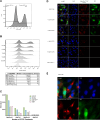An RNA replicon system to investigate promising inhibitors of feline coronavirus
- PMID: 38236006
- PMCID: PMC10878086
- DOI: 10.1128/jvi.01216-23
An RNA replicon system to investigate promising inhibitors of feline coronavirus
Abstract
Feline infectious peritonitis (FIP) is a fatal feline disease, caused by a feline coronavirus (FCoV), namely feline infectious peritonitis virus (FIPV). We produced a baby hamster kidney 21 (BHK) cell line expressing a serotype I FCoV replicon RNA with a green fluorescent protein (GFP) reporter gene (BHK-F-Rep) and used it as an in vitro screening system to test different antiviral compounds. Two inhibitors of the FCoV main protease (Mpro), namely GC376 and Nirmatrelvir, as well as the nucleoside analog Remdesivir proved to be effective in inhibiting the replicon system. Different combinations of these compounds also proved to be potent inhibitors, having an additive effect when combined. Remdesivir, GC376, and Nirmatrelvir all have a 50% cytotoxic concentration (CC50) more than 200 times higher than their half-maximal inhibitory concentrations (IC50), making them important candidates for future in vivo studies as well as clinically implemented drug candidates. In addition, results were acquired with a virus infection system, where Felis catus whole fetus 4 (Fcwf-4) cells were infected with a previously described recombinant GFP-expressing FIPV (based on the laboratory-adapted serotype I FIPV strain Black) and treated with the most promising compounds. Results acquired with the replicon system were comparable to the results acquired with the virus infection system, demonstrating that we successfully implemented the FCoV replicon system for antiviral screening. We expect that this system will greatly facilitate future screens for anti-FIPV compounds and provide a non-infectious system to study and evaluate drug-resistant mutations that may emerge in the FIPV genome.IMPORTANCEFIPV is of great significance in the cat population around the world, causing 0.3%-1.4% of feline deaths in veterinary practices (2). As there are neither effective preventive measures nor approved treatment options available, there is an urgent need to identify antiviral drugs against FIPV. Our FCoV replicon system provides a valuable tool for drug discovery in vitro. Due to the lack of cell culture systems for serotype I FCoVs (the serotype most prevalent in the feline population) (2), a different system is needed to study these viruses. A viral replicon system is a valuable tool for studying FCoVs. Overall, our results demonstrate the utility of the serotype I feline coronavirus replicon system for antiviral screening as well as to study this virus in general. We propose several compounds representing promising candidates for future clinical trials and ultimately with the potential to save cats suffering from FIP.
Keywords: antiviral agents; feline coronavirus; feline infectious peritonitis; replicon.
Conflict of interest statement
The authors declare no conflict of interest.
Figures





References
-
- de Groot RJ, Baker SC, Baric R, Enjuanes L, Gorbalenya AE, Holmes KV, Perlman S, Poon L, Rottier PJM, Talbot PJ. 2011. Family Coronaviridae
Publication types
MeSH terms
Substances
Grants and funding
LinkOut - more resources
Full Text Sources
Research Materials
Miscellaneous

